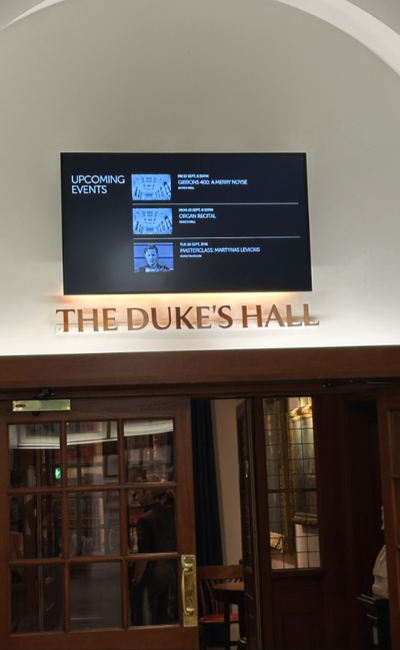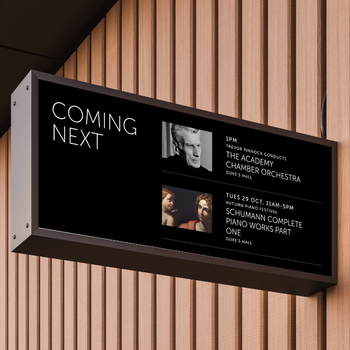When is a website not just a website?
For many cultural organisations, your website has two primary functions.
One, it provides website visitors with information about your organisation – anything from mission statements to information for planning a visit. And two, it facilitates transactions with a ticketing or CRM system, for things like ticket booking and making donations.
But folks, it’s 2025. The world is more wired-up and digital than it ever has been. Almost every piece of software you use day-to-day can talk to other software through an API.
So with the right content management system (CMS), your website can do far more than just those two things: it can be a valuable digital hub at the heart of your organisation. It can automate some of your most common and repetitive day-to-day tasks – freeing-up staff time. And it can even provide up-to-date information to every visitor who walks through your doors, whether that visitor is trying to look at your website or not.
We've shared a few examples of where we've pushed Craft, Supercool's CMS of choice, to do all of this and more for clients including Royal Academy of Music, Cheltenham Festivals and B:Music.
Quick introduction to Craft CMS
So, when is a website not just a website? When it's a Craft CMS website.
We’ve been working with Craft for over ten years, almost as long as it’s existed. We love Craft, and so do our clients, because it was built from the ground-up to be as flexible and easy-to-use as possible.
Unlike a platform like Wordpress, which makes default assumptions about your content, Craft lets you set it up fresh, each time you start a new website project. So for example, whenever we build a website for a Spektrix client, we set up Craft to automatically create event pages for them – based on what it finds in Spektrix.
It also plays nicely with other ticketing systems, CRM platforms – and more. So nicely in fact that many of our clients' websites are now approaching the eight, nine, or even ten-year mark. Because Craft makes it easy to adapt to their changing needs, year after year. (Bonus: Craft is also highly accessible.)
But where Craft really starts to shine is what it can do with data, once it's been integrated with other digital systems …
RAM
Venue screens
At the Royal Academy of Music in London, public areas are peppered with digital screens displaying key information to visitors. Things like upcoming performances, information for alumni, and contact details for hiring the venue.
Before our nifty Craft integration, staff had to manually prepare and manage the visuals for these screens. Time-consuming stuff – especially when event details changed. Plus, once an event had happened, someone had to manually remove it from the screens.
Yet all content for the screens was already in Craft, and automatically updated from Spektrix every day. So, we worked with the Academy to build an extra section in Craft, where they can manage their venue screens, including the event data pulled from Spektrix.
⭐ Now all the team needs to do is select a feed of upcoming events they want to display on their screens. When event information gets updated on the website, it automatically feeds through to the venue screens as well. And once an event has been and gone, it automatically drops off the screens, exactly the same as what happens on the website. No more fiddly manual tasks.
App integration
Cheltenham Festivals offer an app that visitors can download to help manage their (busy) schedules while at the festival.
Previously, setting up this app for every festival was a hugely time-consuming process, with the marketing team spending hours manually re-entering all the same programme information that already existed within Spektrix.
Although the app has the ability to automatically import data, it expected that data in one format, and Spektrix provided it in another. But that's not an issue when you're also working with Craft. Craft is so flexible, it doesn’t care what format data is in. So, we simply set up a feed that takes all data imported from Spektrix, and funnels it to Cheltenham’s app in a format it can understand.
⭐ Now, rather than having to enter the same data into two systems, event information automatically loads into the app at a click of a button – saving the marketing team hours of manual work.
Email integration
B:Music is the charity which runs Birmingham's iconic, world class venues, Town Hall and Symphony Hall. With over 700 events every year, the marketing team is kept very busy.
One of their tasks is sending out weekly emails with details of upcoming events, using the email platform Dotdigital.
Although Dotdigital integrates with Spektrix, and can pull-in some basic event data directly from Spektrix (which the B:Music team does), none of the rich marketing content – such as imagery – exists in Spektrix. Instead, all of this content gets added into Craft, meaning the team had to manually copy things like images and booking links from Craft into Dotdigital.
To streamline this process, we built a plugin for B:Music. It lets them build emails directly in Craft, using all the assets they already have available. (Doing it in Craft also means they can build emails with all the familiar editing tools they already use to manage the website.) Once the email is ready, they can push it into Dotdigital, where it can be proofed, and cued up to send to the right audience segments.
⭐ This integration saves the B:Music team around 10 hours every week!
Benefits of using your website as a 'digital hub'
1) Save your team time
Less manual work gives marketing and digital teams more time to concentrate on the things that actually need their time, brainpower, and expertise. They also don't necessarily need to learn numerous different platforms, as so much can be done right there within a single Craft control panel.
2) Provide audiences with accurate information
Automating repetitive processes reduces the chance and impact of human error. Errors which could have the potential to cause a lot of confusion, anger, stress … (Adding a ticket price with the wrong decimal place, anyone?) Plus, when something does need to be corrected or updated, with this approach that only needs to be done in one system.
3) … and provide that information in real-time
Automating any processes that don't really need human input means that your data will be updated much quicker than if changes need to be made manually. (And it means you don’t need to spend as much time checking manually-inputted data – see 'human error' above.)
Bottom line: your website could do more
Gone are the days when your website sits in its own digital silo. Your website can now be the single source of truth for many other digital systems.
So, make sure you're using your website to its fullest potential – by sharing the information it already contains with any other system that needs it.
Planning a new website? Curious about how it could be more than just a website? Get in touch


